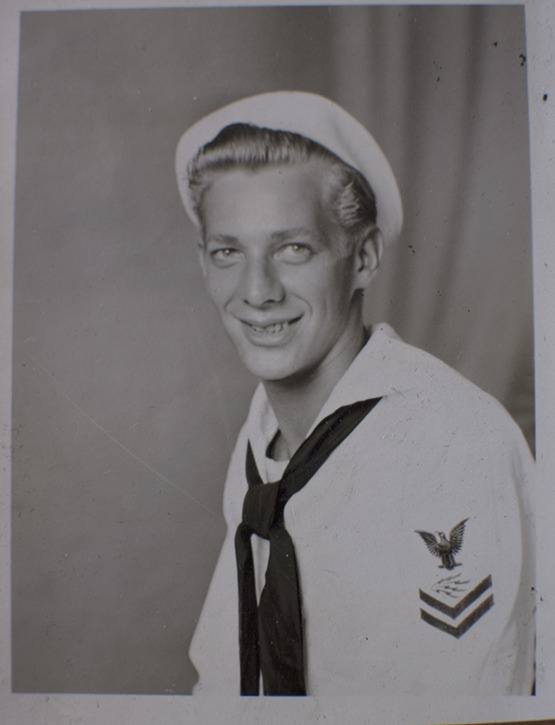The date was December 7, 1941. On this day the history books tell the tale of a giant being awoken. This giant was America. The waker -a barage of bombs dropped on a sleeping island.
Ed Mrazek, originally from Chicago who now lives in Sylvan Lake with his wife Marjorie, remembers the day Pearl Harbour was bombedwell. He was attending college at the time and ultimately this was the day that would put the ‘bug in his ear’ to enlist. A few monthspassed following the bombing and America’s entry into World War II had begun. Mrazek was eager to defend his country so he joined theUnited States Navy.
He soon found himself on a supply ship in the South Pacific.
“We had secured Guadalcanal and Tulagi - we were moving onto another island invasion,” said Mrazek, now 91 years old, referring to theGuadalcanal Campaign fought between August 7th, 1942 and February 9th, 1943 in which Allied Forces took back Tulagi in the SolomonIslands which was under Japanese control. It was the first major offensive by Allied forces against the Empire of Japan.
“It was between 1 and 3 a.m. when we we got torpedoed and sunk - we spent a few hours in the open waters until we got picked up by adestroyer, everyone made it but the medic who I happened to be talking to at the time whose leg was blown off and bled to death whilewaiting for help.”
It wasn’t long after this Mrazek heard the Navy was looking for volunteers with extremely strong swimming skills.
“All I heard was it was some so-called ‘secret missions’ and like a dummy I volunteered,” he remembers. “Underwater Demolition Team(UDT) they called it - little did I know I was joining the nucleus of the U.S. Navy SEALs.”
The UDT were an elite special-purpose force established by the Navy during World War II and were the precursor to present-day UnitedStates Navy SEALs. Their primary function was to observe enemy defensive obstacles and destroy obstacles on beaches prior to landingsof the Marines and Army.
Training for the elite team involved two miles of open ocean swimming per day. During missions, Mrazek and his swimming partner weredropped a mile or more from shore, where they would swim to and from the boat either to recon the area and provide information onobstacles or to deploy explosives.
“Everything in the South Pacific was island hopping - we invaded several islands,” he recalls. “We did some reconnaissance in thePhilippines and a pre-invasion in Luzon, Philippines, next we did reconnaissance on Kwajalein, Marshall Islands,
“At this time it was all clandestine work, none of it was publicized and we weren’t supposed to talk about it.”
The last mission of Mrazek’s Navy career was the Battle of Iwo Jima, which took place from February 19th to March 26th 1945. The majorbattle saw U.S. Marines land on and eventually capture the island of Iwo Jima from the Japanese. The American invasion had the goal ofcapturing the entire island, including the three Japanese-controlled airfields, to provide a staging area for attacks on the Japanese mainislands. This five-week battle comprised some of the fiercest and bloodiest fighting in the Pacific in World War II.
“While we were at Iwo Jima - we did a bit of damage there. We were on the shoreline doing recon and the Japanese were not very happy tosee us and started shooting at us,” said Mrazek. “My swim partner got knicked in the leg and there I was having to drag his butt back tothe boat.
“They picked us up on the fly - they had a rubber boat latched on the side of the ship, they threw us a life ring and pulled us in, we pulledourselves into the rubber boat and they just kept on going.”
The incident earned Mrazek a Bronze Star citation for heroic achievement. Mrazek recalls the day Allied forces raised the flags on MountSuribachi on Iwo Jima. He remembers watching from a few hundred yards away as the American flag was raised and flew proudly above,adding that flag cost the life of 20,000 Allied casualties.
“After that we headed back to the States because to be climatized as were slated to invade Japan main land - that was to be our nextmission. The forecast for invading Japan stated it would cost us more than 1 million casualties,” said Mrazek. “We were all ready to invadeJapan when they dropped the atomic bombs. Everyone said Truman was a nasty man because he did it - but I thought he was a heck of aguy because it meant I didn’t have to go.”
It was eight more months before Mrazek would step foot in Chicago again, but he didn’t mind because he was finally returning home.
Mrazek is currently a member of the Sylvan Lake Legion following his move here with his wife Marjorie and remains an active member of aLegion in Arizona where he and his wife spend their winters.
editor@sylvanlakenews.com
